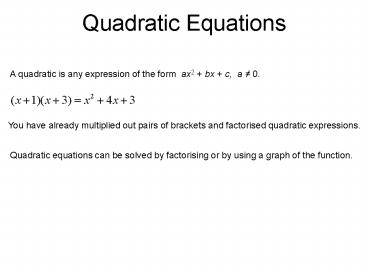Quadratic Equations - PowerPoint PPT Presentation
1 / 18
Title:
Quadratic Equations
Description:
Quadratic Equations A quadratic is any expression of the form ax2 + bx + c, a 0. You have already multiplied out pairs of brackets and factorised quadratic ... – PowerPoint PPT presentation
Number of Views:104
Avg rating:3.0/5.0
Title: Quadratic Equations
1
Quadratic Equations
A quadratic is any expression of the form ax2
bx c, a ? 0.
You have already multiplied out pairs of brackets
and factorised quadratic expressions.
Quadratic equations can be solved by factorising
or by using a graph of the function.
2
Solving quadratic equations using graphs
1. Use the graph below to find where x2 2x 3
0.
Page 71 Exercise 71.
3
Solving quadratic equations using factors
4
Page 72 Exercise 2.
5
Reminder about factorising
Page 73 Exercise 3A
Page 74 Exercise 4A and 4B
6
Sketching quadratic functions
To sketch a quadratic function we need to
identify where possible
The y intercept (0, c)
The roots by solving ax2 bx c 0
The axis of symmetry (mid way between the roots)
The coordinates of the turning point.
7
The shape
The coefficient of x2 is -1 so the shape is
The Y intercept
(0 , 5)
The roots
(-5 , 0) (1 , 0)
The axis of symmetry
Mid way between -5 and 1 is -2
x -2
The coordinates of the turning point
(-2 , 9)
8
Page 75 Exercise 5
9
Standard form of a quadratic equation
Before solving a quadratic equation make sure it
is in its standard form.
Page 76 Exercise 6
10
Solving quadratic equations using a formula
What happens if you cannot factorise the
quadratic equation?
Youve guessed it. We use a formula.
11
WATCH YOUR NEGATIVES !!!
12
Page 77 Exercise 7A
Page 78 Exercise 7B
13
Straight lines and parabolas
In this chapter we will find the points where a
straight line intersects a parabola.
At the points of intersection A and B, the
equations are equal.
B
A
14
Page 79 Exercise 8
15
Quadratic equations as mathematical models
1. The length of a rectangular tile is 3m more
than its breadth. Its area is 18m2. Find the
length and breadth of the carpet.
x3
18m2
x
Not a possible solution
Breadth of the carpet is 3m and the length is 6m.
16
Page 80 Exercise 9 Start at Question 2.
17
Trial and Improvement
The point at which a graph crosses the x-axis is
known as a root of the function.
When a graph crosses the x-axis the y value
changes from negative to positive or positive to
negative.
18
The process for finding the root is known as
iteration.
Hence the graph crosses the x - axis between 1
and 2.
1
-2
1 and 2
2
2
-0.25
1.5 and 2
1.5
0.16
1.5 and 1.6
1.6
-0.048
1.55 and 1.6
1.55
-0.006
1.56 and 1.6
1.56
0.035
1.56 and 1.57
1.57
0.014
1.56 and 1.565
Hence the root is 1.56 to 2 d.p.
1.565
Page 83 Exercise 10






![Solve Simultaneous Equations One Linear, one quadratic [Circle] PowerPoint PPT Presentation](https://s3.amazonaws.com/images.powershow.com/5861858.th0.jpg?_=20200807031)
























